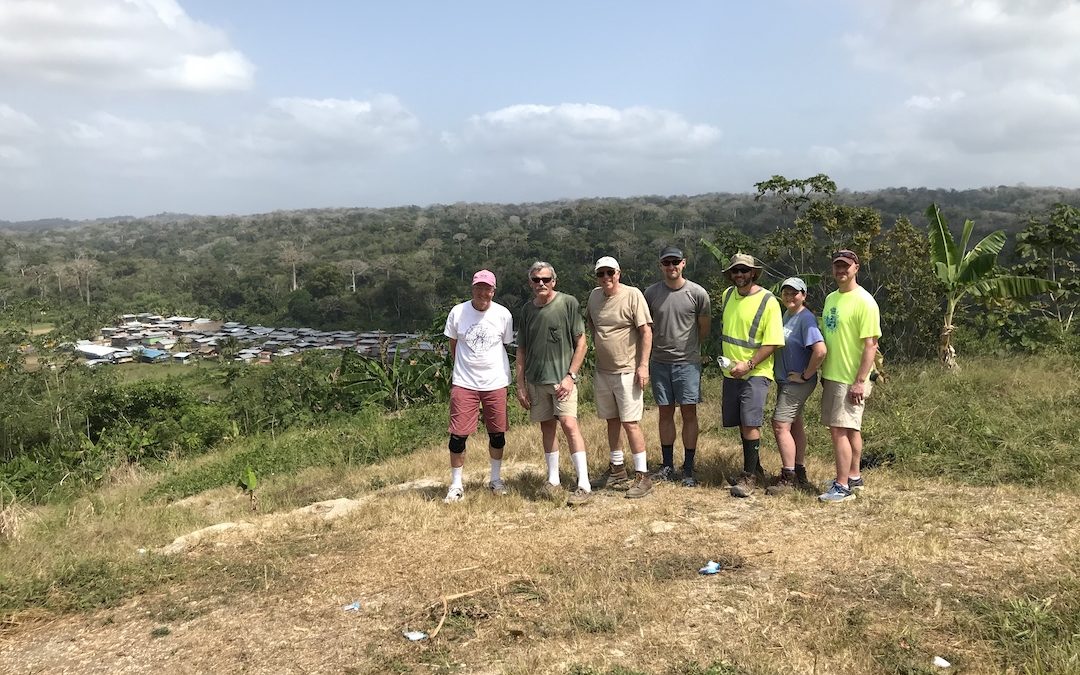From February 8-16, 23 participants representing five congregations through central Virginia joined together on mission to Panama. Although we were commissioned and traveled together, we were two distinctly different teams with different mission plans.
The medical/dental team provided services to indigenous people and those in need in the communities of Gallinaza in the province of Veraguas, and los Guzman in the province of Cocle. The construction team, on which I served, engaged in a project with a Kuna congregation who are building a new church in the very remote jungle community of Morti, in the Darien Province. A forthcoming post from the medical team will highlight their experience, but this post is specifically about our experience in Morti.
On the construction team were:
Sue Smith, Fredericksburg Baptist
Marty Cash, Second Baptist
Jerry Hill, Second Baptist
Russ Collins, RRCB
John Heisler, RRCB
Lawrence Heisler, RRCB
Daniel Ingram, RRCB
Geoff Sundberg, RRCB
Bill Thurston, RRCB
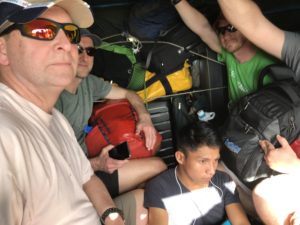 Morti is a nearly six-hour drive east and north from Panama City. We left Panama City the morning of February 9 after making a quick stop to supplement our meals with basic groceries: cereal, granola bars, pb&j, and of course coffee! There was a fair amount of uncertainty about our accommodations in Morti, including meals, so we thought it best to have some options available to us. There were nine of us from the US accompanied by four young men from Panama City, all family members of our primary Panamanian contact, Hernan. We packed ourselves into Hernan’s truck and a very small bus that reminded me of the matatus from trips to Kenya.
Morti is a nearly six-hour drive east and north from Panama City. We left Panama City the morning of February 9 after making a quick stop to supplement our meals with basic groceries: cereal, granola bars, pb&j, and of course coffee! There was a fair amount of uncertainty about our accommodations in Morti, including meals, so we thought it best to have some options available to us. There were nine of us from the US accompanied by four young men from Panama City, all family members of our primary Panamanian contact, Hernan. We packed ourselves into Hernan’s truck and a very small bus that reminded me of the matatus from trips to Kenya.
After a five-hour drive down the Pan-Am Highway, we turned north where we stopped at a farm house. Here we unpacked the bus and repacked in the back of a four-wheel drive pickup truck with a vinyl cover over the back and two narrow bench seats. It made the bus feel like a 787! A couple of minutes into the ride and it was clear why we needed to change vehicles. The last hour of our trip to Morti was an entirely ruddy, hilly, and ever-narrowing dirt road. A few miles from Morti, we cross a bridge made of logs and dirt that washes away every year during the rainy season.
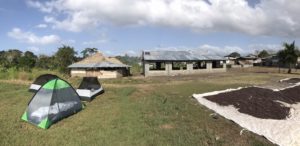 We arrive in Morti Sunday afternoon and are greeted immediately by Kuna villagers. The women immediately take our bags and start hauling them (sometimes two or three bags per person) toward the church building near where we will stay. They lead us to a building that will be ‘home’ for the week. The building has a thatch roof, loosely planked walls, and an earth floor. Knowing it will be dark soon, we set ourselves up for sleeping. Three of us sleeping in hammocks string up our beds inside, and the other six campers set up their tents outside. Many curious eyes watch us as we situate ourselves. A propane range is brought inside to assist with meal prep.
We arrive in Morti Sunday afternoon and are greeted immediately by Kuna villagers. The women immediately take our bags and start hauling them (sometimes two or three bags per person) toward the church building near where we will stay. They lead us to a building that will be ‘home’ for the week. The building has a thatch roof, loosely planked walls, and an earth floor. Knowing it will be dark soon, we set ourselves up for sleeping. Three of us sleeping in hammocks string up our beds inside, and the other six campers set up their tents outside. Many curious eyes watch us as we situate ourselves. A propane range is brought inside to assist with meal prep.
We check out the church building in which we’ll be working this week. Prior to arrival we had been told that they had block walls and a roof in place. We also understood that a base layer of river rock had been laid so that we could work on pouring a cement floor. We also knew that there was a solar electric system in the works and there might be additional electrical work needed. We also anticipated building some doors and shutter windows for the rough block openings.
The solar panel system had been installed. Although there was only one panel in place so far, it was a very impressive system with potential to expand capacity over time. A combination of AC and DC LED lights had been installed in the building and around the exterior so we didn’t have any electrical work for the week. It also provided a way for us to charge devices and tools through the week.
Considerable work had been done gathering rock from the river and spreading it out over the earth floor of the sizeable building. Rocks ranged in size from peas to pumpkins, so leveling the space was going to be a challenge. We had also hoped to have a generator on site to run the cement mixer, but that had not yet materialized. We’d come up with a plan in the morning.
As it grew dark, we had cereal and pb&j sandwiches for dinner and went to bed.
Sleeping in Morti was an adventure of its own. The local roosters don’t bother waiting until dawn to start crowing. It usually began around 1 am, then 2:15, then 3:30, then 4:45. Then the dogs would wake up and start their own conversations from one side of the village to the other. Not to be outdone, the howler monkeys in the distance would begin their song around 5 am. That said, I actually had some of my best sleep in Morti that I’ve had in quite some time. Perhaps it’s the early bedtime, or the fatiguing work during that day.
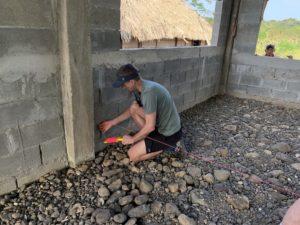 Monday morning, we began preparation work inside the church building. We checked the walls and found them to slope downhill slightly. The two door openings had thresholds at different heights. Given the height of the stone that was selected and necessary depth of the slab we decided on a height for the floor and began building forms. There was a small amount of scrap lumber available to us. We were told if we needed more that we could just strip it off of our ‘home’ building. Using the conduit hangers that we no longer needed and some rebar, we set our first forms.
Monday morning, we began preparation work inside the church building. We checked the walls and found them to slope downhill slightly. The two door openings had thresholds at different heights. Given the height of the stone that was selected and necessary depth of the slab we decided on a height for the floor and began building forms. There was a small amount of scrap lumber available to us. We were told if we needed more that we could just strip it off of our ‘home’ building. Using the conduit hangers that we no longer needed and some rebar, we set our first forms.
Russ and Jerry worked on building doors, harvesting more lumber from the plank siding of the house. Their work made for much better airflow for those of us sleeping in hammocks in the evenings.
 After lunch, and still without a generator, it was decided that would start mixing cement by hand on the earth floor. Two bags of cement, 12 bags of sand, 12 bags of rock, and 5-10 gallons of water. As it turns out, a Kuna pastor from about three hours away was here to help. Also as it turns out, Maralyn (the neighbor pastor) is an expert with cement. Geoff, Lawrence, Maralyn, and I took turns mixing the cement on the ground with shovels. It was backbreaking work. I think we did six rounds like this to pour our first small section of slab. It probably wasn’t more than 60 square feet but took us most of the afternoon.
After lunch, and still without a generator, it was decided that would start mixing cement by hand on the earth floor. Two bags of cement, 12 bags of sand, 12 bags of rock, and 5-10 gallons of water. As it turns out, a Kuna pastor from about three hours away was here to help. Also as it turns out, Maralyn (the neighbor pastor) is an expert with cement. Geoff, Lawrence, Maralyn, and I took turns mixing the cement on the ground with shovels. It was backbreaking work. I think we did six rounds like this to pour our first small section of slab. It probably wasn’t more than 60 square feet but took us most of the afternoon.
Morale was a bit low. Without a generator, we couldn’t sustain that kind of mixing work for the next 4 days. Even at our slow pace, we were running short of rock to mix into the cement. Plus, we were hot and exhausted from just a half-day’s work. Earlier that day we were shown how to get to the river, so once we were done with the pouring, we took a dip to clean up and cool off.
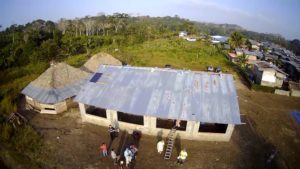 The next morning we were told that a generator and more rock would be delivered by 9 am. A generator did arrive! It was borrowed from the village school. However, when testing it, it leaked a steady stream of fuel. We waited and waited. Marty had brought a drone and thought it would be fun to fire that up. This was certainly a hit with the children, but also allowed for some very cool photography and video. Once the church leaders saw the drone, they wondered if we might assist them in measuring their property lines, because there was no formal record of this. With tape measures and string, we went to work.
The next morning we were told that a generator and more rock would be delivered by 9 am. A generator did arrive! It was borrowed from the village school. However, when testing it, it leaked a steady stream of fuel. We waited and waited. Marty had brought a drone and thought it would be fun to fire that up. This was certainly a hit with the children, but also allowed for some very cool photography and video. Once the church leaders saw the drone, they wondered if we might assist them in measuring their property lines, because there was no formal record of this. With tape measures and string, we went to work.
After lunch, Russ asked me what was wrong with the generator, and I told him it’s leaking fuel. He says, “let’s go look.” A quick inspection showed a steady leak from the carburetor. No problem! For the next hour and half, Russ proceeded to rebuild the carburetor, cutting off enough of the float spring to allow free movement of the valve. After reassembling the carburetor and starting the engine, we were in business!
 That afternoon we started mixing and pouring. We poured a section twice the size of the previous day in less time. We ran out of rock for mixing and harvested rock from the floor of the building to keep us going. We were running low on sand as well. And just when we were finishing this section, a sea of women from the village arrive carrying two sacks of rock each on their backs. This is probably 50 pounds worth. The delivery had arrived and bag after bag of rock and sand were brought hand delivered over a couple hundred yards from the truck to the church. Also on the truck was a generator that had been sent by another church. However, with Russ’s fix, the school’s generator would last us the rest of the week.
That afternoon we started mixing and pouring. We poured a section twice the size of the previous day in less time. We ran out of rock for mixing and harvested rock from the floor of the building to keep us going. We were running low on sand as well. And just when we were finishing this section, a sea of women from the village arrive carrying two sacks of rock each on their backs. This is probably 50 pounds worth. The delivery had arrived and bag after bag of rock and sand were brought hand delivered over a couple hundred yards from the truck to the church. Also on the truck was a generator that had been sent by another church. However, with Russ’s fix, the school’s generator would last us the rest of the week.
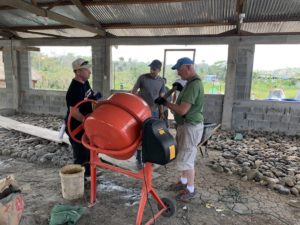 This is how the next couple of days would go. We found a rhythm with mixing and pouring, and just when we thought supplies would run out, another truck would arrive and another sea of women hauling rock and sand would crown the hill to the church.
This is how the next couple of days would go. We found a rhythm with mixing and pouring, and just when we thought supplies would run out, another truck would arrive and another sea of women hauling rock and sand would crown the hill to the church.
I reflected in my journaling about the biblical narrative of Jesus feeding the 5000. The traditional reading of this story has Jesus performing a supernatural act—taking one kid’s fish sandwich and multiplying it into a buffet for a crowd. This might very well be the case; however, I’ve also heard it told this way. What if instead of a supernatural act, it was a simple act of community? As Jesus blesses this small meal and the disciples send it into the crowd, the first person to receive it says, “oh, well I also have a half a loaf of bread, let me add that.” And someone else says, “well I have an apple—perhaps that will be useful.” And this continues so that as everyone shares, everyone is fed. The miracle isn’t a magic trick, the miracle is the generosity of community and the willingness to contribute.
That’s how this week went. Nothing happened on time, or as planned. However, every single moment and every person mattered. Everything needed to happen the way it happened, when it happened. At the end of the day, each day, God provided. And God provided through our work, through the expertise of a cement-finishing local pastor, through the strong backs of the village women, and even through the respite of a cool river. God provides.
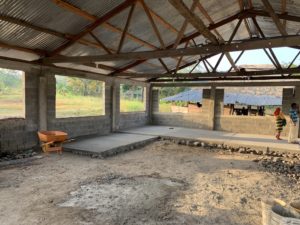 But it was, indeed, hard work in a very difficult environment. Except for the river (which may or may not have been contributed to multiple illnesses) there was no escape from heat, relentless no-see-um bug bites, and fatigue. It took its toll on several team members who were too ill to work on Thursday. Several of us were able to get more sections poured, and decided that was our stopping point. As it turned out, some of the ill team members had to seek medical treatment, so they left late in the afternoon. We wouldn’t see them again until we returned to Panama City the next day. We cleaned up and packed up, so we would be ready to leave the next morning.
But it was, indeed, hard work in a very difficult environment. Except for the river (which may or may not have been contributed to multiple illnesses) there was no escape from heat, relentless no-see-um bug bites, and fatigue. It took its toll on several team members who were too ill to work on Thursday. Several of us were able to get more sections poured, and decided that was our stopping point. As it turned out, some of the ill team members had to seek medical treatment, so they left late in the afternoon. We wouldn’t see them again until we returned to Panama City the next day. We cleaned up and packed up, so we would be ready to leave the next morning.
In the morning, after breakfast, those of us available gathered in the church building. The pastor of the church, Hernan, Marlyn, the team, and any others in the vicinity shared a prayer of dedication for the work that we had done, and the work that would remain. The pastor shared with me his deep gratitude, stating that they wouldn’t have been able to get this started without our help. We took some photos together and then said our goodbyes before making the six-hour trip back to Panama City.
This isn’t the whole story, and there are many more stories within the story that are worth telling. I hope you have the chance to chat with other team members and hear their stories and perspectives. I’m grateful for the opportunity to participate, and I thank you, River Road Church, for sending me! Thank you for your support of global missions efforts, for your support of the ministries and partnership with Greg and Sue Smith. It was indeed a gift and an honor to represent you and to encounter Christ among the Kuna people in Morti.
Written by Rev. Daniel H. Ingram
